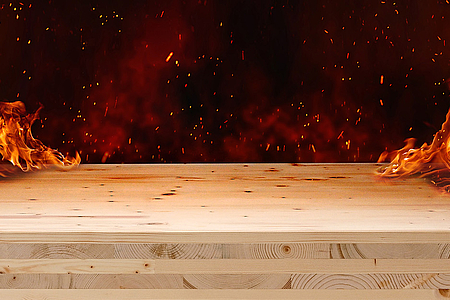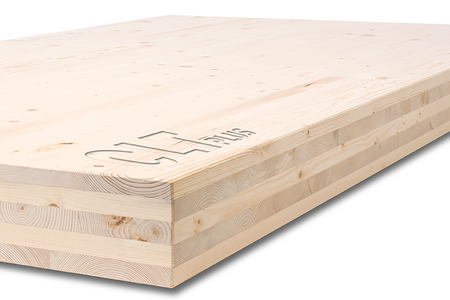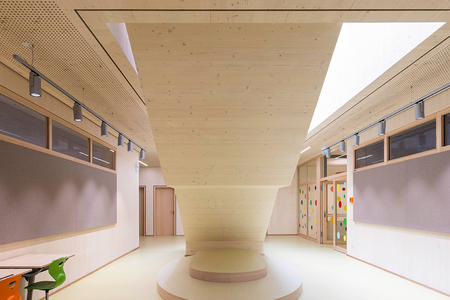Summary of the online seminar “Indoor Air Quality in Timber Construction” presented by Holzforschung Austria on November 17, 2020 – created by the Theurl company, with the kind permission of Holzforschung Austria.
Continually, the media pursue the idea that room air in wooden buildings is polluted with especially high values of Volatile Organic Compounds (VOC), and these levels can be dangerous to health. To obtain facts on this, Holzforschung Austria worked with standardized scientific measurements on two projects that investigate the effect wood has on indoor air quality. Some of the results obtained were presented at the online seminar “Indoor Air Quality in Timber Construction”.
VOC - volatile organic compounds
Before starting the considerations, there is a fundamental question: What exactly are VOCs? The abbreviation stands in English for "volatile organic compounds" and in German for "flüchtige organische Verbindungen". At certain temperatures, these are gaseous substances that contain carbon. VOCs can be detected indoors as well as outdoors. They can have a biological or artificial origin. Currently, there is no clear, generally applicable definition of indoor air quality, although it has a major impact on occupants. However, only knowing the quantity of VOCs present does not suffice to evaluate possible impacts on health or well-being. Thus, relatively high amounts of toxicologically harmless substances can be uncritical, while even very small amounts of other toxicologically harmful substances should be avoided. Depending on the substance type and amount, indoor air can cause health problems, for example irritating the eyes or respiratory tract. So what we can do at present is to take a closer look at the individual substances and recommended VOC values found. Concerning indoor air quality, Holzforschung Austria mainly worked on measuring VOC, as well as formaldehyde and other short-chain carbonyl compounds.
There was one thing to consider in these types of measurements: With this method, emissions cannot be attributed to specific materials that cause them. For example, if one finds terpenes (unsaturated hydrocarbons), they can come from walls (in a wooden house), furniture or even an existing wooden floor as well as from cleaning agents. In order to ascertain the exact source, separate measurements would have to be made directly on the materials.
Every substance has emissions
In short, VOC sources are: EVERYTHING! VOC always surround us. In the construction phase and after moving in, materials used are the main emitters. This can be wood, plasterboard, concrete and many other building materials such as paint, varnish and much more, including furniture, textiles and carpets. However, the longer a house is inhabited, the greater the effect of the residents’ behavior. Using perfume, hairspray, cosmetics, air fresheners, cleaning agents, detergents, fabric softeners and many other products changes the VOC composition in indoor air. Cooking also releases some VOC. Emissions from smoking or the use of vaporizers should also not be forgotten.
Quantity prediction hardly possible
It is difficult to predict the expected concentrations in a building because there is a mix of materials in every room. To make matters even more complicated, the materials influence each other. For example, surfaces can bind the substances for a short or long time. Permanent absorption or blocking is also possible. All of these materials make predicting indoor air quality extremely complicated.
Evaluation criteria for indoor air
Most countries have their own specifications and guidelines for evaluation. In Austria, the BMK (Federal Ministry for Climate Action, Environment, Energy, Mobility, Innovation and Technology) indoor air working group specifies the guide values, which can be viewed on its website:
https://www.bmk.gv.at/themen/klima_umwelt/luft/luft/innenraum/rl_luftqualitaet.html
Projekt Wood2New
The Wood2New project was conducted from 2014 to 2017. Holzforschung Austria was involved in the project along with many other international players. The project not only focused on indoor air quality, but also revolved around general topics regarding building and living in a wooden house. As part of Holzforschung Austria’s work, indoor air of 13 different, newly built prefabricated houses made with different construction methods, was examined over several months: one concrete structure, six buildings with a solid timber construction and 6 six buildings with a wood frame construction. The first room air sample was taken during the construction phase. Six more samples were then taken approximately monthly after moving in. The room in which the samples were taken was also determined in advance: Inasmuch as people spend the longest time in the bedroom at home, measurements were taken in that room. https://www.holzforschung.at/forschung-entwicklung/projektliste/details/wood2new-18/
Significant drop in the first few months
As a general statement, it can be said that after a few months the choice of building material no longer led to really large differences in VOC quantities in the air. However, because the amount of VOC can only be one indicator of the toxicological assessment, project partner Dr. Karl Dobianer provided a detailed toxicological assessment for each building, with striking results obtained in two buildings due to residents’ behavior, while the indoor air quality corresponded in the other buildings.
Project IASca
Holzforschung Austria’s second project was called “IASca” (Indoor Air Scavenger). Scavenger materials can absorb and bind substances from the air. The project was dedicated to the question of whether it might be necessary to use scavenger materials in buildings in order to possibly absorb initial high VOC substance concentrations. This Austrian Research Promotion Agency (FFG) project was also carried out with several project partners, including the Österreichisches Institut für Bauen und Ökologie GmbH. Large-scale indoor air measurements as part of the project included 74 existing buildings that had been occupied for 3 to 8 years. Types of buildings examined included solid timber buildings, wood frame buildings and houses built using mineral materials.
Hardly any differences in the construction methods
The results showed that a few years after moving in, only minor differences can be demonstrated between the various construction methods. The exact breakdown of substance types shows that for some properties with increased VOC total values, it is not the emissions typical of wood construction that make up the largest proportion of the amount, but a whole range of other substances. Furthermore, measurements also showed the recommended value of 100 μg/m³ for formaldehyde was observed in all properties. The toxicological assessment of the results by the MedUni Vienna was largely positive. Occupant satisfaction and well-being were also generally very high in the wooden buildings.
Taking a closer look at the measurement results according to building types and substance groups, it becomes apparent that no construction method has any particular advantages or disadvantages in terms of long-term indoor air quality. The statement that there is generally poor indoor air quality in wooden houses is therefore unsubstantiated. Using scavenger materials to reduce substance concentrations is not necessary if the construction is carried out according to the state of the art and normal ventilation habits. https://www.holzforschung.at/forschung-entwicklung/projektliste/details/iasca-48/
More information and results can be found on Holzforschung Austria’s homepage or on request.

Elisabeth Habla, Holzforschung Austria
Mag.ª Elisabeth Habla studied chemistry at the University of Vienna. Since 2012, she has been investigating various issues in the field of wood emissions at Holzforschung Austria. She is active in project work and project management in national and international research projects on the subject of indoor air and human health/well-being and was project leader of the presented IASca project.















